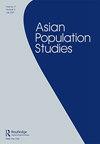Migration and non-integration in two non-western cities: Dubai and Singapore
IF 1.5
4区 社会学
Q2 DEMOGRAPHY
引用次数: 3
Abstract
According to the World Migration Report 2015 (International Organisation for Migration, 2015, p. 39), among major cities with the largest proportion of foreign-born population, Dubai and Singapore are the only two non-western cities to rank among the top 19 metropolises, mainly European, North American or Australian. The intersection of migration and urban studies constitutes an expanding field of research in which western cities are overrepresented, and scholars seem reluctant to think outside western paradigms of multiculturalism and integration when exploring the ways migrants are incorporated into global cities. Yet the demographic reality of migrant numbers and proportions suggests that there is much to be gained by training the analytical spotlight elsewhere. Along with the globalised economies of Singapore and Hong Kong, the Gulf Cooperation Council (GCC) countries are now among polities with the lowest prospects for the integration and permanent settlement of large migrant populations, even where migrants have become the majority of the total population (Shah, 2017). Hosting about 30 million migrants and their descendants, Gulf countries, one of the most urbanised region in the world, have become the third largest migration-receiving region from the 2000s. The GCC-Asia corridor is the largest South-South corridor, with the majority of migrants coming from Asia, especially South Asia. In the United Arab Emirates (UAE), for example, Indian and Pakistani communities outnumber the 1.1 million Emirati citizens (Bel-Air, 2018). Dubai and Singapore, and more generally Gulf and Asian cities, are interesting case studies from a comparative perspective, as they help extend our thinking about patterns of incorporation of migrants in cities beyond the hegemonic western paradigm of integration (Pagès-El Karoui, 2020). Here, we note the double meaning of integration: the Durkheimian notion of the way individuals are included in the society to achieve social cohesion, and – the definition more frequently adopted for migrants – the provision of pathways to include migrants as part of the nation-state through processes of naturalisation. In both senses and at various levels, Dubai and Singapore are exemplars of non-integration, unveiling the contradictory logics of inclusion and exclusion. The comparison between Dubai (3.3 million inhabitants) and Singapore (5.7 million), two highly diverse cities, is instructive in demographic terms. At 92 per cent, the migrant share of the population in Dubai is a world record, while non-citizens account for 43 per cent of the population in Singapore (World Economic Forum, 2017). This comparison is all the more interesting in that Dubai was nicknamed ‘Singapore of the Middle两个非西方城市:迪拜和新加坡的移民与非融合
根据《2015年世界移民报告》(国际移民组织,2015年,第39页),在外国出生人口比例最大的主要城市中,迪拜和新加坡是仅有的两个跻身前19大大都市的非西方城市,主要是欧洲、北美或澳大利亚。移民和城市研究的交叉构成了一个不断扩大的研究领域,在这个领域中,西方城市的比例过高,学者们在探索移民融入全球城市的方式时,似乎不愿意跳出西方多元文化和融合的范式。然而,移民人数和比例的人口现实表明,通过在其他地方培训分析聚光灯,可以获得很多好处。与新加坡和香港的全球化经济体一样,海湾合作委员会(GCC)国家目前是大规模移民人口融合和永久定居前景最低的政体之一,即使移民已成为总人口的大多数(Shah,2017)。海湾国家是世界上城市化程度最高的地区之一,自2000年代以来,该地区已成为第三大移民接收地区,收容了约3000万移民及其后代。海湾合作委员会亚洲走廊是最大的南南走廊,大多数移民来自亚洲,尤其是南亚。例如,在阿拉伯联合酋长国(UAE),印度和巴基斯坦社区的人数超过了110万阿联酋公民(Bel Air,2018)。迪拜和新加坡,以及更广泛的海湾和亚洲城市,从比较的角度来看,都是有趣的案例研究,因为它们有助于将我们对移民融入城市模式的思考扩展到西方霸权的一体化范式之外(Pagès-El Karoui,2020)。在这里,我们注意到融合的双重含义:涂尔干关于个人融入社会以实现社会凝聚力的概念,以及——移民更经常采用的定义——通过归化过程提供将移民纳入民族国家的途径。无论从何种意义上还是在不同层面上,迪拜和新加坡都是不一体化的典范,揭示了包容和排斥的矛盾逻辑。迪拜(330万居民)和新加坡(570万居民)这两个高度多样化的城市之间的比较在人口统计方面具有指导意义。迪拜移民占人口的92%创下了世界纪录,而非公民占新加坡人口的43%(世界经济论坛,2017)。这种比较更有趣的是,迪拜被戏称为“中东的新加坡”
本文章由计算机程序翻译,如有差异,请以英文原文为准。
求助全文
约1分钟内获得全文
求助全文
来源期刊

Asian Population Studies
DEMOGRAPHY-
CiteScore
3.30
自引率
14.30%
发文量
12
期刊介绍:
The first international population journal to focus exclusively on population issues in Asia, Asian Population Studies publishes original research on matters related to population in this large, complex and rapidly changing region, and welcomes substantive empirical analyses, theoretical works, applied research, and contributions to methodology.
 求助内容:
求助内容: 应助结果提醒方式:
应助结果提醒方式:


